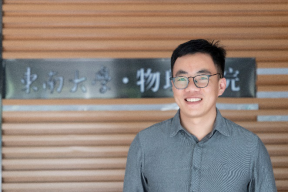
李强,副研究员/博士,[博士生导师]
2015年10月毕业于德国卡尔斯鲁厄工业学院纳米研究所(Helmholtz Scholarship-Helmholtz Research School Energy-Related Catalysis),主要从事机制与数据驱动的新材料设计、光电半导体材料电子结构性质以及功能材料的多尺度模拟。获得江苏省双创博士(2019),新葡的京集团35222vip“至善青年学者”A层次(2021)。以第一作者/通讯作者发表SCI论文40余篇,包括Angew. Chem. Int. Ed.、Adv. Mater.、Nano Letter、Adv. Funct. Mater.、Materials Today、Appl. Cat. B: Environ.,J. Phys. Chem. Lett.,J. Mater. Chem. A,Small method,Nanoscale等。
研究领域:
(1) 机制与数据驱动的新材料设计
(2) AI for Science 相关方法以及先进智能体的开发与应用
(3) 光电半导体等材料电子结构性质的理论研究
(4) 功能材料的多尺度模拟
工作经历:
2021/04 –至今 新葡的京集团35222vip 副教授
2018/04 - 2021/03 新葡的京集团35222vip 副研究员
2016/03-2018/03新葡的京集团35222vip博士后
教育经历:
2012/07 - 2015/10德国卡尔斯鲁厄工业学院纳米研究所/物理化学系 理论化学
2009/09 – 2012/03 上海交通大学化学化工学院物理化学
2005/09 – 2009/06淮阴师范学院化学化工学院化学
科研项目:
(1) 人工智能驱动先进材料设计横向课题(350万) 主持 2025-2028
(2) 负载型团簇催化剂在多碳耦合反应中构效机制的理论研究国家自然科学基金面上项目主持2022-2025
(3) 构效关系导向的数据挖掘算法开发应用及催化性能机器学习预测国家重点研发计划课题骨干2022-2026
(4) 数据驱动的催化材料设计方法及大规模智能筛选国家重点研发计划课题骨干2022-2026
(5) 电驱动合成医药化学品过程数据增强及跨尺度建模新策略重大研究计划重点项目课题骨干2025-2028
(6) 新型二维半导体材料及其异质结构中电子结构与性能保护的理论研究国家自然科学基金青年基金项目主持项目批准号21703032, 2018-2020.
(7) 江苏省双创博士-世界名校类, 2019,主持
部分学术成果:
(1)Wu, M.; Sun, J.; Cui, Y.; Fan, L.; Hong, K.; Liu, W.; Li, Q.*; Lyu, Z.; Wang, J. Active Learning‐Driven Discovery of Donor‐Acceptor Covalent Triazine Frameworks for High‐Performance Photocatalysts. Adv Funct Materials2025, 2505234. https://doi.org/10.1002/adfm.202505234.
(2)Li, Q.; Lu, C.; Karin, J. D.; Zhang, Y.; Ling, C.; Zhang, X.; Zhou, Z.; Wang, J.; Prezhdo, O. V. Dual-Defect Donor–Acceptor Pairing in Metal Oxide Semiconductors for Enhanced CO2 Photoreduction. Nano Lett.2025, 25(46), 16507–16514. https://doi.org/10.1021/acs.nanolett.5c04671.
(3)Lin, W.; Liu, F.; Song, Z.; Zhang, Y.; Zhou, Q.; Ling, C.; Li, Q.*; Wang, J. Feature-Extended Descriptor Construction for Prediction of Consecutive Elementary Reaction Energies in Methane Oxidation. Chem. Mater.2025, acs.chemmater.5c00930. https://doi.org/10.1021/acs.chemmater.5c00930.
(4)He, D.; Wang, Q.; Rong, Y.; Xin, Z.; Liu, J.-J.; Li, Q.*; Shen, K.; Chen, Y. Sub-Nanometer Mono-Layered Metal–Organic Frameworks Nanosheets for Simulated Flue Gas Photoreduction. Adv. Mater.2024, 36(27), 2403920. https://doi.org/10.1002/adma.202403920.
(5)Ouyang, Y.; Shi, L.; Bai, X.; Ling, C.; Li, Q.*; Wang, J. Selectivity of Electrochemical CO2 Reduction toward Ethanol and Ethylene: The Key Role of Surface-Active Hydrogen. ACS Catal.2023, 13(23), 15448–15456. https://doi.org/10.1021/acscatal.3c03797.
(6)Zhang, Y.; Wang, B.; Ouyang, Y.; Zhou, Y.; Li, Q.*.; Wang, J. Toward Low-Symmetry Systems: An Adaptive Differential Evolution Algorithm for Global Structure Searching. J. Phys. Chem. Lett.2022, 13(13), 2986–2993. https://doi.org/10.1021/acs.jpclett.2c00649.
(7)Li, Q.*; Zhang, Y.; Shi, L.; Wu, M.; Ouyang, Y.; Wang, J. Dynamic Structure Change of Cu Nanoparticles on Carbon Supports for CO 2Electro‐reduction toward Multicarbon Products. InfoMat2021, 3(11), 1285–1294. https://doi.org/10.1002/inf2.12229.
(8)Li, Q.*; Zhao, Y.; Ling, C.; Yuan, S.; Chen, Q.; Wang, J. Towards a Comprehensive Understanding of the Reaction Mechanisms Between Defective MoS2 and Thiol Molecules. Angew. Chem. Int. Ed.2017, 56(35), 10501–10505. https://doi.org/10.1002/anie.201706038.
https://www.researchgate.net/profile/Qiang-Li-318
